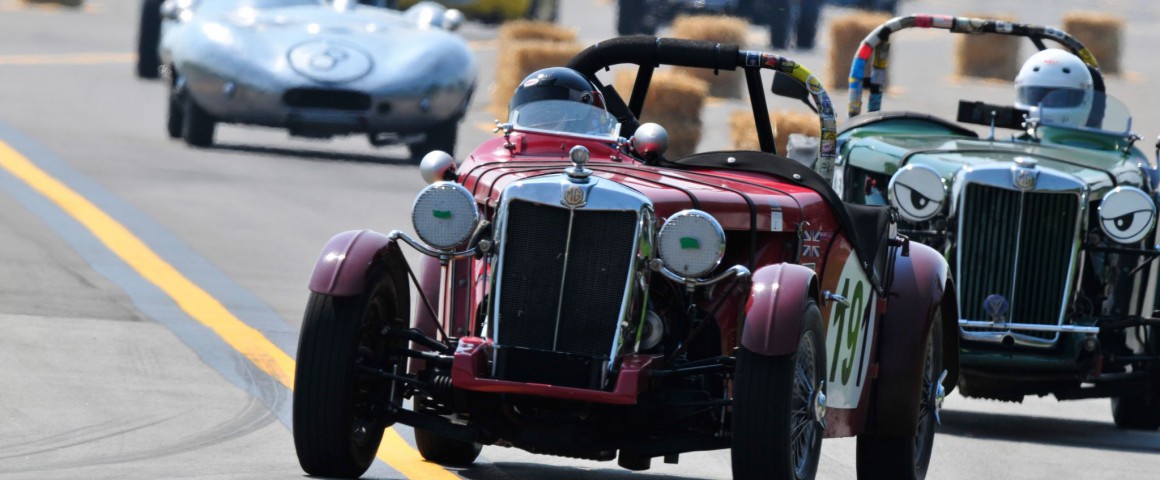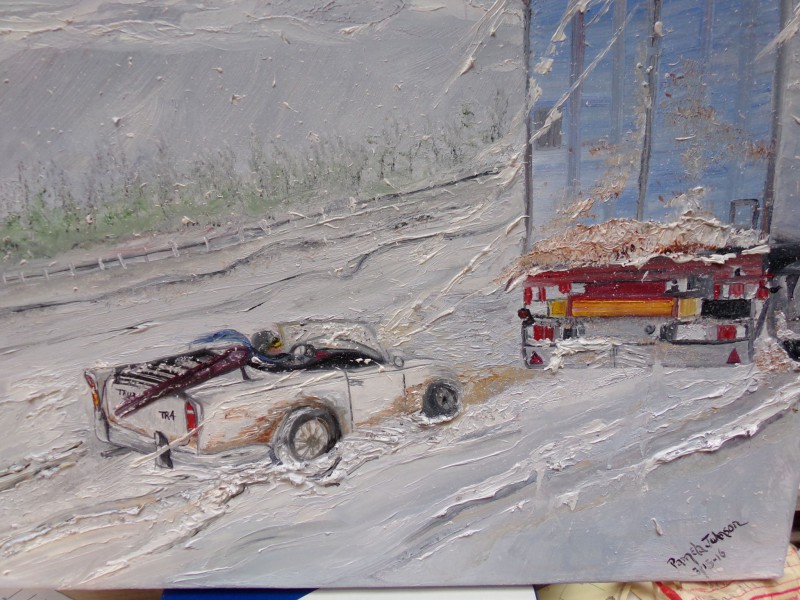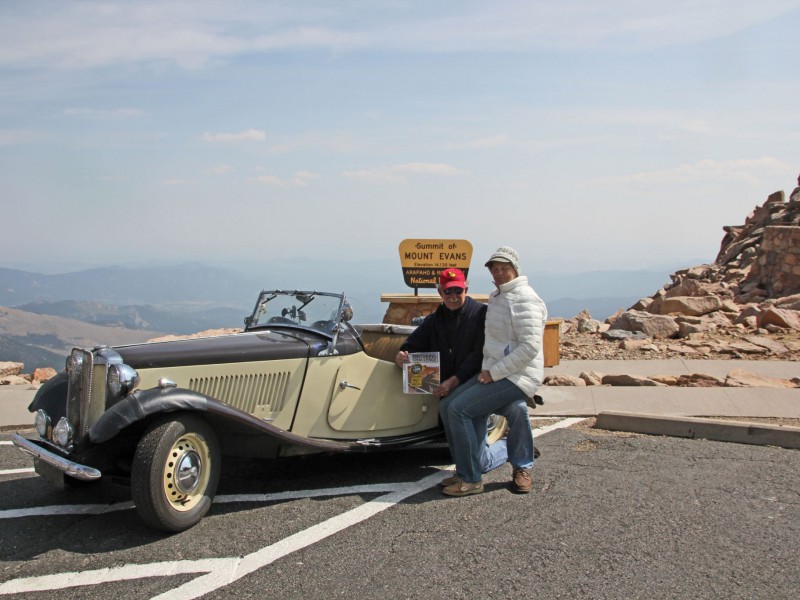Story by Walt J. Peterson
Photos by Stu Kerr
Step off of the Port Clinton ferry onto the island and you can imagine this is Nassau, 1955, Speed Week. On this warm morning, sports cars with electrician’s tape numbers are parked along the sidewalk while their owners and companions raid tourist shops and sip drinks in street-side cafes. Wait a minute; here comes a dude in a little race-tuned British sports car. As he and his lady friend rock by your eardrums, you understand the local authorities must be winking at this kind of behavior. Along airport road, there are hay bales against poles and a sign that says “Turn 2: The Dog Leg.” An arrow above it points you west.
This is South Bass Island off of Ohio’s north coast. Carroll Shelby is gone. Moss has retired and Fon de Portago is a faded memory. The road races held here on streets a half century ago have not been forgotten, though. This is the Put-in-Bay Reunion Road Race. The event aims to recreate the 1950s races; witness the chopped windscreens and hear the open pipes bellow!
On the dock I rented a bike from a girl with a Spanish accent who told me, “A left and two rights,” and I could pedal easily to the race at the airport course. Traffic is civilized. My bike had a coaster brake circa the 50s and handlebars as wide as a Texas long horn. I shared the road with golf carts and sporty cars.
Once clear of the town, there seems no urgency along the tree-lined road. South Bass Island, a half hour from the mainland, aims to be relaxed, unpretentious. The locals ignore their own “Private Road No Admittance” signs, sharing the atmosphere of the reunion week race at the airport. The private houses border the airport on the leeward side of the narrow island. You can view the course from backyards and the residents don’t seem to mind. Some airplane hangars bordering the course/runway serve as viewing points, too. Their massive open doors echo the sweet sounds of speed.
The reunion week recalls the Cleveland Sports Car Club’s small-bore races held here from 1952-1959. In 2009, organizers—chiefly Jack Woehrle and Bob Williams—held the first reunion for about 35 entrants. This year there are over a hundred sports cars entered for the race, touring and exhibition. Entrants soak up the atmosphere of this vintage bash. Races are run on Monday and Tuesday (after the mail plane lands). Wednesday the car show is scheduled. Manley Ford, a participant and organizer, hesitates to call it a concourse, “It’s just a car show,” he chuckles when I ask for clarification. Participants are encouraged to ferry cars across the water leaving trailers and transporters on Ohio’s shore where the corn stalks are tall and apples will be ready in a few weeks.
If you want to tour the original island course, the roads and bends are marked. Nowadays, the racing is safer on the course set up on the airport runways where tri-motor Fords landed regularly into the ’70s. After 1959, Ohio banned racing on state roads. In 1963, PIB saw what the Cleveland Sports Car Club considered an outlaw race held by the Detroit SCC—a valiant attempt to resurrect the island race. The competition was promptly stopped when an Elva went off course and hit several trees. The driver, however, was unhurt, and the races held from the ’50s till then had a near spotless safety record here.
THEY’RE NOT PLAY-ACTING
With a suspension of disbelief properly tuned, time travel here is a breeze. Little cars slow and fast dance by: MGs, Triumphs, square-bodied Spridgets, there is a way-cool Volvo B544, a Turner, Porsches, and an Elva sports racer that frequents Pittsburgh Vintage Grand Prix. Not many string-back gloved dilatants seem to be out there. For 2015 the racing surface had been improved and expanded. Viewing is open all around the airport and there is a good perspective of the featurelessness of airport courses—one of the chief reasons these flat, rectangular courses fell out of favor and were replaced by purpose-built courses in the1960s. Airport racers work on a stage with little to identify braking points, turn-in markers and relative speed. Corner workers (angels in white uniforms) calmly view the action from behind concrete barriers till they are cued to deliver critical action.
Today’s course is crafted from the two roughly parallel runways connected by a hundred-eighty degree turn at each end. The starting grid dumps directly on to the main runway. Looking down the grid and beyond the front straight you can see the monument to the Battle of Lake Erie in 1812 above the trees and more than a mile away. But who would notice the obelisk with a gaggle of sports cars around you snarling and spitting like prep school brats?
Drive straight down the pit, out and onto the front straight accelerating smartly. You come to an off-set left lined with the time-honored cordon of hay bales to guide cars through. A quick flick left and then past the race headquarters building with the start/finish line and the biggest spectator area. A second off-set left signaled again by a hay-bale wall on either side of your car. Through the jog and there is a nice straight toward the first 180-degree turn at the east end that will head you up the parallel runway. A series of gates formed by three rows of pylons forces you to zigzag through. Set up wide and carry enough speed and you are rewarded with the fastest straight on the course. Farther up, the second 180 turn at the opposite end of the race course waits to test you. Coming down the front straight again, you’ll get the green flag at the start/finish in front of race control (which 363 days of the year is the airport administration building). As the pace quickens and the tires heat up, tar strips and white lines for aircraft come at you at an alarming rate, but there is no luxury time to think about them or your friends in the bleachers. The hay bales seem to be much closer together, to almost merge. Driving the racecar ten laps is riveting and physically demanding. It’s like playing a musical instrument while dancing—a wrong note or a wrong step can cost you. Whew!
Some people wonder if vintage racing is really authentic, i.e., like it used to be “back in the day.” Fair question. These honestly aren’t the same cars. They have grip and a rev range the racers of the 50s couldn’t dream of. How real is that? Vintage racing is what we have. Nothing is ever what it used to be, nor should it be necessarily. Remember too, gentle reader, safety science back then hadn’t caught up with speed. We are miles ahead on that front.
Like Oliver Hazzard Perry’s monument to the War of 1812, the massive concrete column is not the battle itself. It represents the battle. Vintage racing, in part, is a kinetic monument or, better yet, performance art providing a journey back in time.
And vintage racing is theater. As a journalist and racer, Denise McCluggage traded paint with and wrote about the best international drivers who came to America in the 50s and 60s. Today, South Bass Island is a stage and the events of these three days recreate the substance of drama. Organizers, like writers and playwrights, take shards of memory, reassemble them and give old cars new life. What McCluggage said is still true, “The players arrived, set up the props, improvised a grand entertainment before an appreciative audience and moved on. Sometimes the drama was greatest behind the scenes. Sometimes a supporting player took a star turn. Sometimes there were death scenes.”
How long will vintage racing last? That’s up to all of us. Come to Put-in-Bay at the end of August. The principals will be here. They build it yearly. You can be part of it. For the competition, I’d put my money on that smokin’ hot, white Elva that seemed to eat everybody’s lunch last year in the feature race. But don’t count out the Porsches, Alfas and a yellow Lotus from Texas.


















'Put-In-Bay Race Reunion' has no comments
Be the first to comment this post!